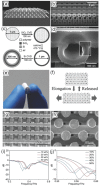Additive Manufacturing: Applications and Directions in Photonics and Optoelectronics
- PMID: 30775219
- PMCID: PMC6358045
- DOI: 10.1002/adom.201800419
Additive Manufacturing: Applications and Directions in Photonics and Optoelectronics
Abstract
The combination of materials with targeted optical properties and of complex, 3D architectures, which can be nowadays obtained by additive manufacturing, opens unprecedented opportunities for developing new integrated systems in photonics and optoelectronics. The recent progress in additive technologies for processing optical materials is here presented, with emphasis on accessible geometries, achievable spatial resolution, and requirements for printable optical materials. Relevant examples of photonic and optoelectronic devices fabricated by 3D printing are shown, which include light-emitting diodes, lasers, waveguides, optical sensors, photonic crystals and metamaterials, and micro-optical components. The potential of additive manufacturing applied to photonics and optoelectronics is enormous, and the field is still in its infancy. Future directions for research include the development of fully printable optical and architected materials, of effective and versatile platforms for multimaterial processing, and of high-throughput 3D printing technologies that can concomitantly reach high resolution and large working volumes.
Keywords: 3D printing; additive manufacturing; direct ink writing; electrospinning; light‐emitting devices; optical sensors; waveguides.
Figures













References
-
- ISO/ASTM Standard 52900 , Standard Terminology for Additive Manufacturing – General Principles – Part 1: Terminology, ISO/ASTM International, Switzerland: 2015.
-
- Bourell D. L., Annu. Rev. Mater. Res. 2016, 46, 1.
-
- Martin J. H., Yahata B. D., Hundley J. M., Mayer J. A., Schaedler T. A., Pollock T. M., Nature 2017, 549, 365. - PubMed
-
- Hirt L., Reiser A., Spolenak R., Zambelli T., Adv. Mater. 2017, 29, 1604211. - PubMed
Publication types
LinkOut - more resources
Full Text Sources
Other Literature Sources
